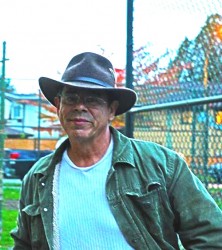Article Origin
Volume
Issue
Year
It’s been a decade since a Vancouver Sun article described the Downtown Eastside as “Four Blocks of Hell”, complete with hypodermic needles and “sex-trade detritus” on the ground, and urine-drenched alleyways.
While the article was primarily intended to spotlight a pilot clean-up project for the area, it mostly succeeded in advertising the waste and decay of this neighbourhood.
Vancouver ALIVE (Aboriginal Life In Vancouver Enhancement) Society founder Scott Clark observes that the ghettoization of residents in the DTES is particularly detrimental to Indigenous peoples.
Advocates for this area call for more services, more social housing and more homeless shelters. Clark has an entirely different perspective.
The centralization of services in the blocks surrounding Main and Hastings create a ghetto where opportunities for upward social and economic mobility are stunted, he said.
Instead, Clark supports a “continuum of housing” that helps people “exit the DTES”. Mixed housing, he said, would bring new demographics to the neighbourhood, boosting business and the opportunity for enterprise. It would also lessen the very real stigma associated with those four troublesome blocks; a stigma that Scott Clark doesn’t hesitate to call an issue of settler colonialism.
“I call it colonialism, straight up.”
He said the troubling reality is that charity organizations are building empires off the commodification of Indigenous people in need on the Downtown East Side.
Scott Clark is clear that this brand of “help” is not actually meeting the true needs of the neighbourhood, but rather keeping people contained there in a state of stagnation.
It is time for other areas of the city, and other cities entirely, to take some responsibility, to welcome current DTES residents, particularly Aboriginal residents and to end the cycle of ghettoization, he believes.
This is what Clark terms an empowerment lens and is part of a broader Musqueum model, developed by former Musqueum chief Wendy Grant John.
The model outlines a collective approach to the homelessness and poverty crisis effecting Aboriginal people in Vancouver.
The Musqueum model is about collective action and community support. It rejects the notion that poverty and homelessness are problems of an individual, a character flaw or personal failing.
The approach recognizes the responsibility of all citizens and, indeed, of all people, to care about the plight and the injustices of others. It asks that we demand more of our society and our government.
While social and Indigenous rights activists have stood firmly against the encroaching gentrification of the DTES, Clark doesn’t think that the “G word” is the most threatening monster to face the community.
An influx of new residents and the distribution of social housing throughout the city, rather than sandwiched between Gastown, Chinatown and the financial district, could finally break the cycle of poverty and addiction. But others disagree.
On March 1, a media conference was held at The Lion Hotel after tenants of the 74-bed SRO (Single Room Occupancy) Hotel learned that the building was being sold.
A Canada Mortgage and Housing Corporation loan had previously allowed the hotel’s owner to keep rents low. If the building is sold, tenants run the risk of losing their last remaining safety net before homelessness.
Residents of the Lion Hotel are asking the Lookout Society, an Emergency Aid group providing subsidized beds and rooms for those in need across the lower mainland, to take over the hotel, allowing them to stay.
The Lookout Society runs 12 centres in the area surrounding the Lion Hotel, most of which are within a three-block radius of each other. That is more locations than they have in Vancouver Central, New Westminster, Burnaby and the North Shore combined.
- 2051 views

